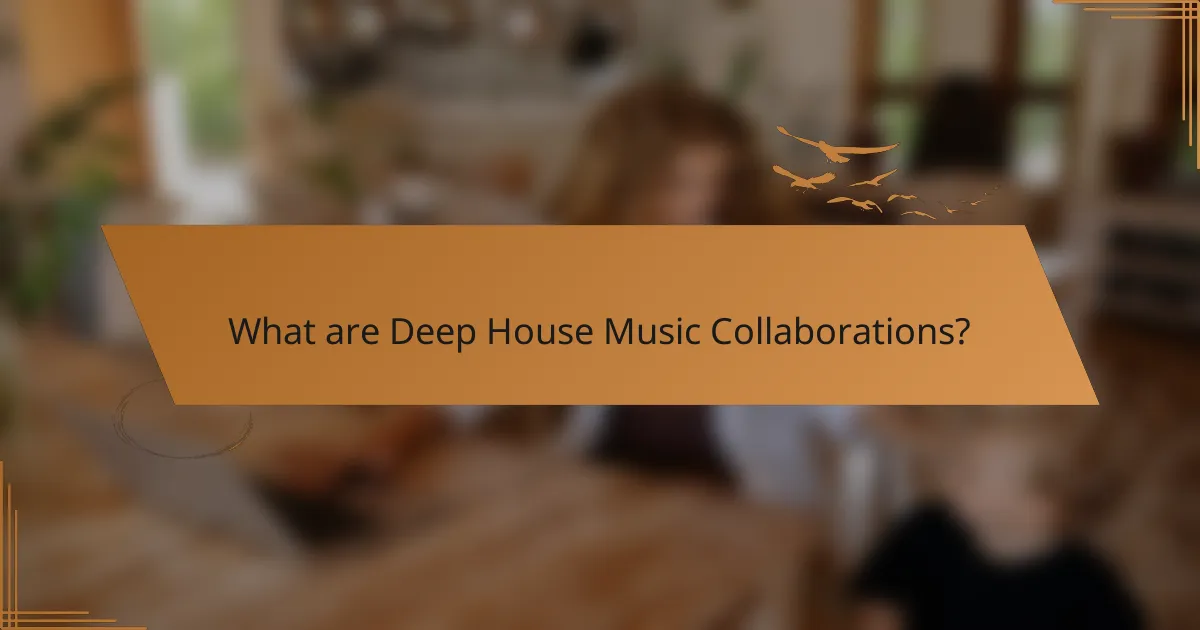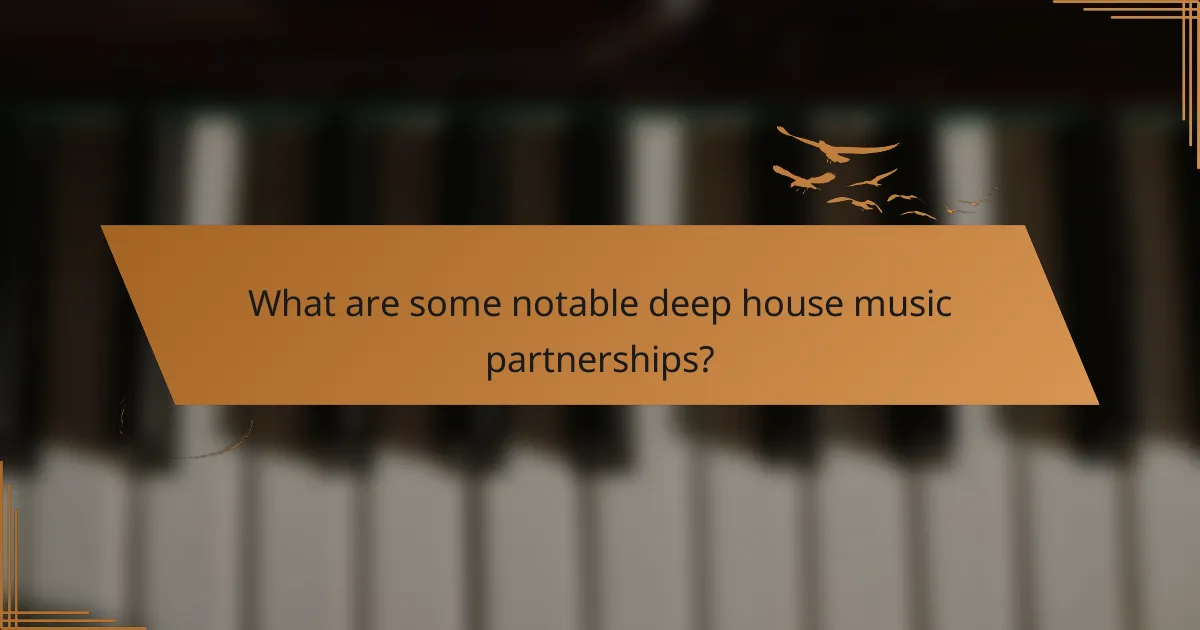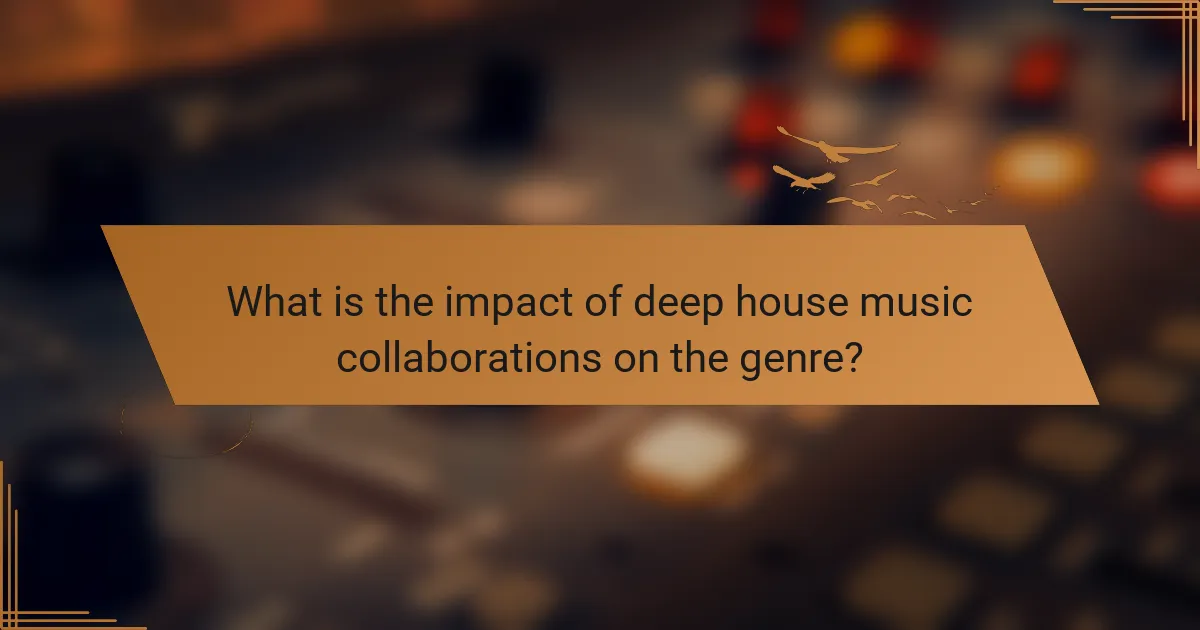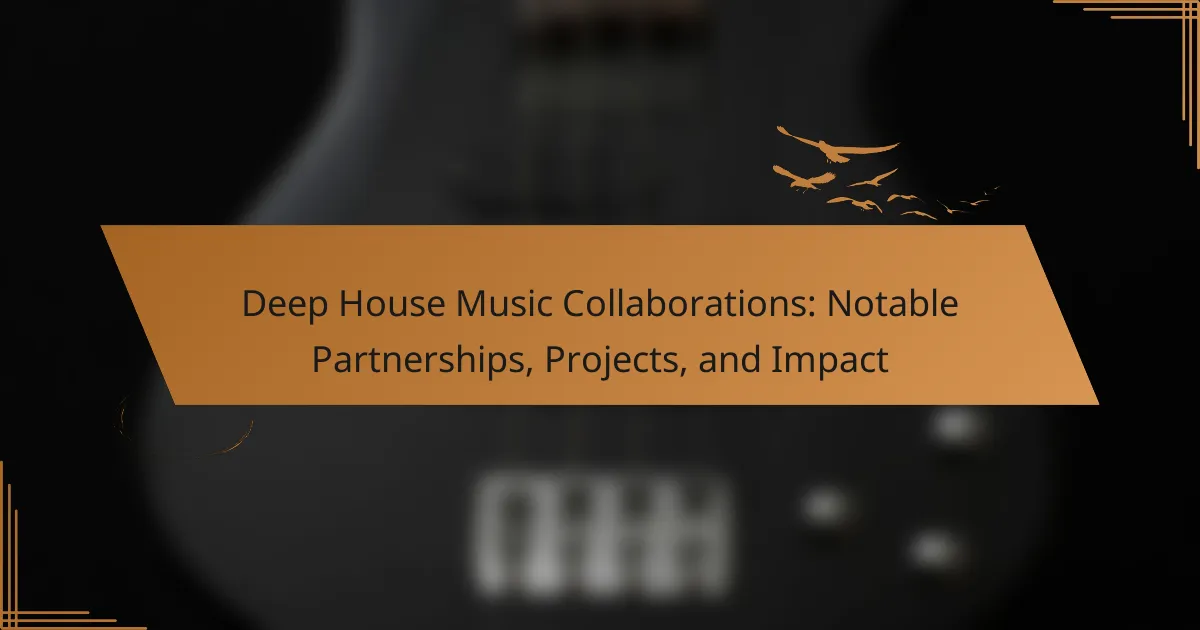Deep House Music Collaborations refer to partnerships between artists, including producers, vocalists, and instrumentalists, aimed at creating deep house tracks that blend unique styles and influences. Notable collaborations, such as those between Disclosure and Sam Smith, or Duke Dumont and Jax Jones, showcase the innovative fusion within the genre, often leading to chart-topping hits. These partnerships enhance the diversity and reach of deep house music by introducing new sounds and attracting wider audiences, while also providing increased exposure for both established and emerging artists. The impact of these collaborations significantly shapes the evolution and popularity of the deep house music scene.

What are Deep House Music Collaborations?
Deep House Music Collaborations are partnerships between artists to create deep house tracks. These collaborations often blend unique styles and influences. They can involve producers, vocalists, and instrumentalists working together. Notable examples include artists like Disclosure and Sam Smith. Such collaborations can enhance creativity and expand audience reach. They often result in chart-topping hits and critically acclaimed albums. The impact of these partnerships can significantly shape the deep house music scene.
How do collaborations shape the deep house music genre?
Collaborations shape the deep house music genre by blending diverse influences and expanding creative boundaries. Artists often combine unique styles, which leads to innovative sounds. This fusion enhances the genre’s appeal to broader audiences. Collaborations also foster community within the music scene. Notable partnerships, like those between deep house producers and vocalists, create memorable tracks. These tracks often gain traction on streaming platforms, increasing visibility for all involved. Furthermore, collaborations can lead to live performances that showcase the genre’s dynamism. Overall, they play a crucial role in the evolution and popularity of deep house music.
What roles do artists play in deep house collaborations?
Artists in deep house collaborations serve multiple roles, including producers, vocalists, and instrumentalists. Producers create the underlying tracks, shaping the sound and structure. Vocalists contribute lyrics and melodies, enhancing emotional depth. Instrumentalists add unique sounds, enriching the musical texture. Collaborations often involve blending diverse styles, which fosters innovation. This synergy can lead to chart-topping hits and increased visibility for all involved. For instance, collaborations between notable artists often result in successful tracks that define the genre.
How do producers influence the collaboration process?
Producers significantly influence the collaboration process in deep house music. They shape the creative direction and sound of a project. Producers often select the artists involved, impacting the collaboration’s overall style. They provide technical expertise, which enhances the quality of the music. Producers also manage the recording process, ensuring that sessions run smoothly. Their vision can inspire artists to explore new musical ideas. Collaborative decisions on arrangement and mixing are often guided by producers. This leadership role can lead to innovative outcomes in deep house music.
Why are collaborations important in the music industry?
Collaborations are important in the music industry because they foster creativity and innovation. Artists combine their unique styles and skills, resulting in fresh and diverse sounds. This synergy often leads to higher-quality music that resonates with a wider audience. Collaborations can also expand an artist’s reach by introducing them to new fan bases. For example, the collaboration between Daft Punk and Pharrell Williams on “Get Lucky” significantly boosted both artists’ popularity. Additionally, collaborations often create buzz and excitement, driving sales and streaming numbers. According to a report by Nielsen Music, collaborative tracks consistently rank higher on charts, demonstrating their commercial viability.
What impact do collaborations have on artist visibility?
Collaborations significantly enhance artist visibility in the music industry. They allow artists to tap into each other’s fan bases. This cross-pollination often leads to increased exposure and new audience engagement. Collaborations can also result in higher streaming numbers and chart performance. For instance, a study by Spotify found that collaborative tracks often receive more playlist placements. This boosts visibility on the platform. Additionally, collaborations can lead to media coverage and promotional opportunities. Artists often gain credibility through partnerships with established names. Overall, collaborations are a strategic tool for increasing visibility in a competitive landscape.
How do collaborations contribute to the evolution of music styles?
Collaborations contribute to the evolution of music styles by blending diverse influences and techniques. They allow artists to experiment with new sounds and genres. For example, the collaboration between Daft Punk and Pharrell Williams on “Get Lucky” fused electronic and funk elements. This partnership resulted in a fresh sound that impacted both artists’ careers and the music industry. Collaborations also facilitate cross-genre innovations, as seen in the merging of deep house with pop and hip-hop. The varied backgrounds of collaborating artists bring unique perspectives, driving stylistic changes. Historical trends show that many music genres have evolved through collaborations, such as the rise of hip-hop through sampling and features. Ultimately, these partnerships create new musical landscapes that reflect cultural shifts and audience preferences.

What are some notable deep house music partnerships?
Notable deep house music partnerships include Disclosure and Sam Smith. Their collaboration on “Latch” achieved significant commercial success. Another key partnership is Between Friends and the producer L.A. Salami. Their track “Better” showcases a blend of deep house and pop elements. Additionally, Duke Dumont has worked with Jax Jones on the hit “I Got U,” which topped charts globally. A prominent duo is Gorgon City, known for their collaborations with artists like MNEK on “Ready for Your Love.” These partnerships highlight the innovative fusion within the deep house genre.
Who are the key artists known for their collaborations in deep house?
Key artists known for their collaborations in deep house include Disclosure, Duke Dumont, and Jamie Jones. Disclosure is recognized for their tracks with Sam Smith and AlunaGeorge. Duke Dumont has collaborated with artists like Jax Jones and A*M*E. Jamie Jones is known for his work with various underground artists, enhancing the deep house scene. These collaborations have significantly influenced the genre’s evolution and popularity.
What are some landmark tracks resulting from these partnerships?
Landmark tracks resulting from deep house music collaborations include “Can’t Get Enough” by Soulsearcher. This track exemplifies the genre’s infectious groove and soulful vocals. Another significant track is “Deep End” by John Summit, which gained immense popularity in 2020. “Cola” by CamelPhat and Elderbrook also stands out, having topped charts worldwide. These tracks showcase the successful fusion of artists’ styles in deep house music. Their impact on the genre is evident through chart performance and listener engagement. Each track highlights the creative synergy within partnerships in the deep house scene.
How have these collaborations influenced the careers of the artists involved?
Collaborations in deep house music have significantly influenced the careers of the artists involved. These partnerships often lead to increased exposure and access to new audiences. For instance, artists like Disclosure gained mainstream recognition through collaborations with Sam Smith. This exposure can result in higher streaming numbers and sales. Collaborations also allow artists to experiment with different sounds and styles, enhancing their creative range. Notably, the collaboration between Black Coffee and David Guetta expanded Black Coffee’s global reach. Such partnerships can also lead to nominations and awards, further validating an artist’s work. Overall, collaborations serve as a strategic move for career growth in the competitive music industry.
What are the most significant deep house music projects?
The most significant deep house music projects include “Deep House Amsterdam,” “Anjunadeep,” and “Defected Records.” Deep House Amsterdam is a platform known for showcasing emerging talent and established artists. Anjunadeep is a record label that has released numerous influential deep house tracks. Defected Records has a rich history of producing chart-topping deep house music. Each project has contributed to the genre’s evolution and popularity. These projects have been pivotal in shaping the sound and community of deep house music.
What collaborative albums have made an impact in the deep house scene?
Collaborative albums that have made an impact in the deep house scene include “The Future” by Black Coffee and David Guetta. This album showcased a blend of African rhythms and electronic sounds, influencing the global deep house movement. Another significant album is “Distant Worlds” by Âme and Dixon, which features a unique fusion of deep house and techno elements. Their work has been pivotal in shaping the sound of modern deep house. Additionally, “Fabric 93” by various artists, curated by the renowned DJ, has played a crucial role in defining the genre’s direction. These albums reflect the collaborative spirit that drives innovation within the deep house community.
How do live collaborations differ from studio projects?
Live collaborations involve performing music in real-time in front of an audience. They emphasize spontaneity and interaction with the crowd. Musicians can adapt their performances based on audience reactions. This often leads to unique renditions of songs. In contrast, studio projects focus on pre-planned recordings in controlled environments. They allow for precise editing and production techniques. Studio work emphasizes sound quality and arrangement over immediate audience feedback. Both formats serve different artistic purposes within the deep house music genre.

What is the impact of deep house music collaborations on the genre?
Deep house music collaborations significantly enhance the genre’s diversity and reach. They introduce new sounds and styles, broadening the creative possibilities within deep house. Collaborations often combine various musical influences, enriching the genre’s texture. Notable partnerships can lead to innovative tracks that capture wider audiences. For example, the collaboration between Disclosure and Sam Smith produced hits that gained mainstream success. This crossover appeal can attract listeners who might not typically engage with deep house. Additionally, collaborations often result in increased exposure for both established and emerging artists. The synergy created in these partnerships can foster community and inspire future collaborations. Overall, deep house music collaborations play a crucial role in the genre’s evolution and popularity.
How do collaborations affect the sound and style of deep house music?
Collaborations significantly influence the sound and style of deep house music. They blend diverse musical backgrounds and techniques. This fusion creates unique tracks that reflect multiple influences. Collaborations can introduce new elements, such as different vocal styles or instrumental layers. Notable partnerships often lead to innovative sounds that push genre boundaries. For example, the collaboration between Disclosure and Sam Smith resulted in a fresh take on deep house. Such partnerships can also enhance production quality through shared expertise. The result is a richer listening experience that attracts a broader audience.
What trends have emerged from collaborative efforts in deep house?
Collaborative efforts in deep house have led to several notable trends. One trend is the blending of genres, where deep house artists incorporate elements from techno, jazz, and soul. This fusion creates a richer sound palette and attracts diverse audiences. Another trend is the rise of virtual collaborations, especially during the COVID-19 pandemic. Artists have utilized online platforms to create music together despite geographical barriers. Additionally, collaborations often result in cross-promotional strategies, enhancing visibility for all involved artists. Data shows that tracks featuring multiple artists tend to perform better on streaming platforms. These trends highlight the evolving nature of deep house through collaboration.
How do collaborations help in the discovery of new talent?
Collaborations help in the discovery of new talent by merging diverse skills and perspectives. This synergy often leads to innovative soundscapes in deep house music. Established artists can introduce emerging talents to their audiences. For instance, collaborations can result in tracks that showcase unique styles or techniques. This exposure can significantly enhance an artist’s visibility in the industry. Additionally, joint projects often attract media attention, further promoting new artists. Historical examples include collaborations like Disclosure and Sam Smith, which propelled Smith into the spotlight. Such partnerships create a platform for new voices in the deep house genre.
What challenges do artists face in deep house collaborations?
Artists face several challenges in deep house collaborations. One major challenge is creative differences. Artists may have varying visions for the sound and direction of the project. This can lead to conflicts during the production process. Another challenge is communication barriers. Misunderstandings can arise if artists do not effectively convey their ideas. Additionally, logistical issues can complicate collaborations. Scheduling conflicts and geographical distances often hinder productive sessions. There is also the challenge of brand alignment. Artists must ensure their styles and public images complement each other. Lastly, financial considerations can pose difficulties. Budget constraints may limit resources for production and promotion. These factors collectively impact the success of deep house collaborations.
How can creative differences be resolved in a collaboration?
Creative differences in a collaboration can be resolved through open communication. Team members should express their ideas and concerns clearly. Establishing a common goal helps align perspectives. Utilizing compromise allows for blending different creative inputs. Seeking feedback from neutral parties can provide fresh insights. Regular meetings can facilitate ongoing dialogue and adjustments. Documenting decisions ensures everyone is on the same page. These strategies are effective in fostering collaboration and enhancing creativity.
What are common pitfalls to avoid in music partnerships?
Common pitfalls to avoid in music partnerships include poor communication, unclear agreements, and lack of trust. Poor communication can lead to misunderstandings about roles and responsibilities. Unclear agreements may result in disputes over revenue sharing and ownership rights. Lack of trust can hinder collaboration and creativity. Research shows that 70% of partnerships fail due to these issues. Addressing these pitfalls proactively can enhance the success of music collaborations.
What best practices can enhance deep house music collaborations?
Effective communication is essential for enhancing deep house music collaborations. Clear dialogue between artists fosters understanding and creativity. Setting shared goals aligns the vision of all collaborators. Regular feedback during the creative process ensures everyone is on the same page. Utilizing collaborative platforms allows for seamless sharing of ideas and tracks. Scheduling dedicated sessions helps maintain focus and momentum. Respecting each other’s artistic styles encourages innovation. Lastly, networking within the deep house community can lead to fruitful partnerships and opportunities.
How can artists effectively communicate during collaborations?
Artists can effectively communicate during collaborations by establishing clear goals and expectations. This ensures all parties understand their roles and contributions. Regular check-ins and updates help maintain alignment throughout the project. Utilizing collaborative tools like shared documents and communication platforms fosters transparency. Active listening is crucial; artists should value each other’s ideas and feedback. Setting deadlines keeps the collaboration on track and accountable. Open discussions about creative differences can lead to innovative solutions. Documenting agreements helps avoid misunderstandings and ensures everyone is on the same page.
What strategies can lead to successful collaborative projects?
Successful collaborative projects require clear communication and defined roles. Establishing open lines of communication fosters trust among team members. Clearly defined roles help each participant understand their responsibilities. Regular check-ins can ensure everyone stays aligned with project goals. Utilizing collaborative tools enhances organization and efficiency. Setting measurable objectives allows for tracking progress effectively. Encouraging feedback promotes continuous improvement throughout the project. Lastly, celebrating milestones can boost morale and strengthen team cohesion.
Deep House Music Collaborations are partnerships among artists that create innovative tracks by blending diverse styles and influences, enhancing creativity and audience reach. The article explores how these collaborations shape the deep house genre, the roles of artists involved, and the significant impact on artist visibility and career growth. Notable partnerships, landmark tracks, and the evolution of music styles through collaboration are discussed, along with the challenges and best practices for successful projects. Overall, the content highlights the importance of collaborations in driving the deep house music scene forward.
